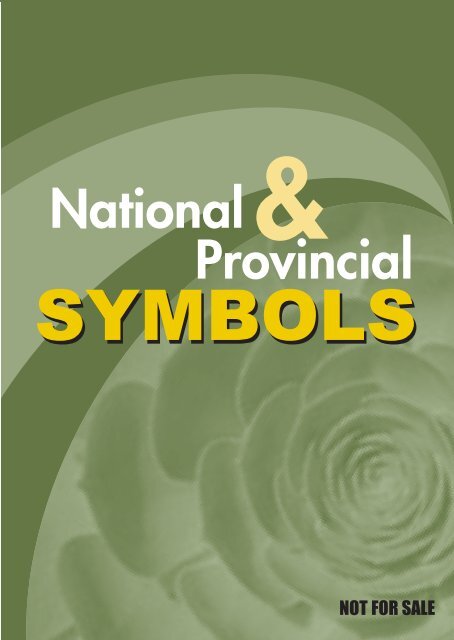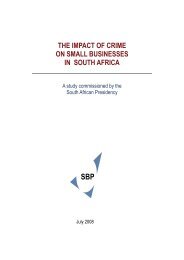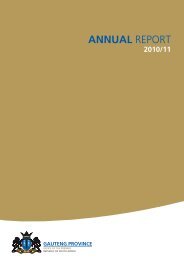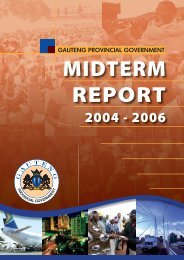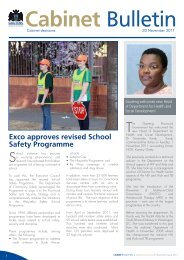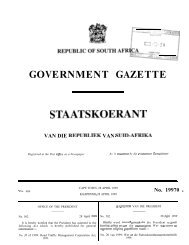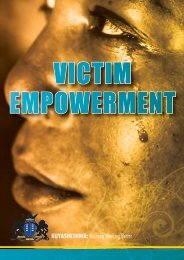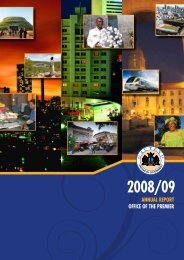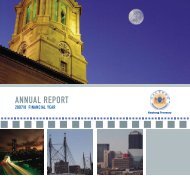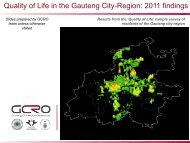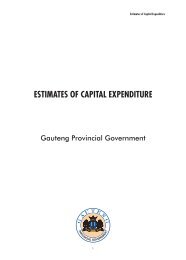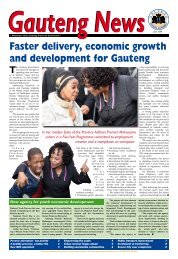SYMBOLS SYMBOLS - Gauteng Online
SYMBOLS SYMBOLS - Gauteng Online
SYMBOLS SYMBOLS - Gauteng Online
You also want an ePaper? Increase the reach of your titles
YUMPU automatically turns print PDFs into web optimized ePapers that Google loves.
&NationalProvincial<strong>SYMBOLS</strong>NOT FOR SALE
Contents123456National Coat of ArmsThe symbol of the National Coat of ArmsDesign of the Ntional Coat of ArmsThe Design ProcessThe new National Coat of Arms enhances Batho Pele<strong>Gauteng</strong> Provincial Government Logo<strong>Gauteng</strong> Coat of ArmsFeaturesCorrect use and misuse of the <strong>Gauteng</strong> Provincial LogoNational FlagSymbolismFlying the FlagRespect the National flagFlag stationsTimes and Sizes when the flag should be flownCeremonies or Commemorative daysFlag staffHalf-masting the National FlagHoisting the National FlagNational AnthemHistoryNkosi Sikelel’ iAfricaThe call of South AfricaNational plants and animalsNational animalNational FlowerNational BirdNational TreeNational FishSources3
HERALDRYThe Heraldry (Act nO. 18 of 1962) as ammended makes provision for theestablishment of a bureau of heraldry committee and a heraldry council; forthe registration and protection of coats of arms, badges, other emblems,names and uniforms; and for other matters incidental thereto.THE HERALDRY (ACT NUMBER 18 OF 1962) AS AMENDEDDEFIES THE HERALDIC TERMS AS FOLLOWS:“BADGE”Means any object or figure, being a symbolic representation, but not displayed ona shield, in conformity with the principle and rules of heraldry, with or without acrown, helmet, crest,mantling supporters,motto or other accessories.“COAT OF ARMS”Means any object or figure being a symbolic representation displayed in colourson a shield in conformity with the principles and rules of Heraldry, with or withouta crown, helmet, crest, mantling, supporters, motto or other accessories.“HERALDIC REPRESENTATION”Means a coat of arms, badge or any other emblem.“OTHER EMBLEM”Means any flag, pennant, gonfalon, decoration, medal, seal, insigna of rank, anyoffice of rank, any office or order or other or kindred symbolic representstion,but does not include a coat of arms or badge.“UNIFORM”Means any article or articles of wearing apparel, being distinctive in design andcolour, but without a heraldic representstion as part thereof, intended to beused by members of an association or institution which is not of a political orreligious character. (Definition of uniform substituted by s. 1(h) of act No. 63 of1980).5
ROLE OF THE COAT OF ARMS:A Provincial Coat of Arms is the highest visual symbol of a Province.Absolute authority is given to every document with an impression of theGreat seal on it.REGISTRATION, AMENDMENT, OR DELETION OF HERALDICREPRESENTATION, NAME, SPECIAL NAME OR UNIFORM:SECTION 10 OF THE HERALDRY ACT (ACT 18 1962) ASAMMENDED STIPULATES THE FOLLOWING:IF AN APPLICATION FOR THE REGISTRATION, AMEND-MENT OR DELETION OF A HERALDIC REPRESENTATION,NAME, SPECIAL NAME OR UNIFORM IS APPROVED BY THESTATE HERALD, COMMITTEE OR COUNCIL.The bureau shall, in the case of an application for registration, enter in the registerthe particulars determined by the State Herald in respect of that heraldicrepresentation, name, special name or uniform, and the bureau shall give noticein the Gazette of the registration and issue to the applicant a certificate of registrationin the form determined by the state Herald.APPLICATIONS AND APPEALSTHE HERALDRY ACT (ACT 18 OF 1962) AS AMMENDED STIPULATES INSECTION 7. ON APPLICATIONS AND APPEALS THE FOLLOWING:Any official or municipal authority, association, institution or person may apply tothe bureau for registration of a Heraldic representation, or of any amendmentor the deletion of Heraldic representation which has been registered in its orhis name.The State Herald may, subject to the provisions of section 19 and with the consentof the committee, delete any heraldic representation, name, special name oruniform if he is satisfied that the official or municipal authority, association orinstitution in whose name it has been registered no longer exists.DEMAGES FOR MISUSE OF REGISTERED HERALDIC REPRESENTATIONS,NAMES,SPECIAL NAMES FOR UNIFORMS:SECTION 21.ANY PERSON WHO-Without the written authority of the association or institution in whose nameany name, special special name or uniform has been registered, or without being6
a member of such association or institution, uses such name, special name oruniform or a material part thereof or any replica or reproduction thereof or anyimitation which may reasonably be confused with any such name, special nameor uniform; orWithout the written authority of the official or municipal authority, association,institution or person in whose name any Heraldic representation has been registeredor, if such person has died, of the widow any other lawful reason, wears,uses, sells, barters or trades in any such heraldic representation or a materialpart thereof or any replica or reproduction thereof or any imitation whichmight reasonably be confused with any such heraldic representation, may besued in court of law by any such official or municipal authority, association, orperson or widow of such person for-An amount not exceeding one thousand rand, and such court may withoutproof of any demages, and in addition to the cost of the action,award such amount, not exceeding the said amount, as may in the circumstancesof the case appear to it to be reasonable; orDamages or an interdict or for both demages and an interdict, and suchcourt may, in addition to the costs of the action, award such demages asmay appear to it to be reasonable in the circumstances, or grant an interdictor both award demages and grant an interdict.SECTION 20. OF THE HERALDRY ACT (ACT 18 OF 1962) AS AMMENDEDSTATES:Nothing in this Act shall prevent any person from using any registered heraldicrepresentation,-name, special name or uniform in the course of or for the purposeof any stage play, historical-peagant or other form of performance orentertain or any cinematographic film, provided it is-not used in such a manneror under such circumstances as to bring it into ridicule or contempt.-/Sub-s substitutedby s. 17(a) of Act No.54 of 1969/.Nothing in this Act shall prevent the continued use of any mark or design registeredunder the-Designs,Trade Marks and Copyright Act, 1916, or any mark ordsign not protected under that -Act but which has been bona fide used as atrade mark before the commencement of this Act:-Provided that the onus ofproving such bona fide use shall be upon the person making such claim.7
THE NATIONAL COAT OF ARMSThe oval shape of foundation• The mottoThe motto is: !ke e: /xarra //ke, written in the Khoisan languageof the /Xam people, literally meaningdiverse people unite. Itaddresses each individual effort to harness the unity betweenthought and action. On a collective scale it calls for the nationto unite in a common sense of belonging and national pride -unity in diversity.• The ears of wheatAn emblem of fertility, it also symbolises the idea of germination,growth and the feasible development of any potential. It relatesto the nourishment of the people and signifies the agriculturalaspects of the Earth.9
• Elephant tusksElephants symbolise wisdom, strength, moderation and eternity.• The shieldIt has a dual function as a vehicle for the display of identity and ofspiritual defence. It contains the primary symbol of our nation.• The human figuresThe figures are derived from images on the Linton stone, a worldfamousexample of South African rock art, now housed and displayedin the South African Museum in Cape Town.The Khoisan,the oldest known inhabitants of our land and most probably ofthe Earth, testify to our common humanity and heritage as SouthAfricans and as humanity in general.The figures are depicted in anattitude of greeting, symbolising unity.This also represents thebeginning of the individual’s transformation into the greater senseof belonging to the nation and by extension, collective humanity.• The spear and knobkierieDual symbols of defence and authority, they in turn represent thepowerful legs of the secretary bird.The spear and knobkierie arelying down, symbolising peace.The oval shape of ascendance• The proteaThe protea is an emblem of the beauty of our land and the floweringof our potential as a nation in pursuit of the AfricanRenaissance.The protea symbolises the holistic integration offorces that grow from the Earth and are nurtured from above.10
The most popular colours of Africa have been assigned to theprotea – green, gold, red and black.• The secretary birdThe secretary bird is characterised in flight, the natural consequenceof growth and speed. It is the equivalent of the lion onEarth.A powerful bird whose legs - depicted as the spear andknobkierie - serve it well in its hunt for snakes, symbolising protectionof the nation against its enemies. It is a messenger of theheavens and conducts its grace upon the Earth. In this sense it is asymbol of divine majesty. Its uplifted wings are an emblem of theascendance of our nation, while simultaneously offering us its protection.It is depicted in gold, which clearly symbolises its associationwith the sun and the highest power.• The rising sunAn emblem of brightness, splendour and the supreme principle ofthe nature of energy, it symbolises the promise of rebirth, theactive faculties of reflection, knowledge, good judgement andwillpower. It is the symbol of the source of life, of light and theultimate wholeness of humanity.The completed structure of the Coat of Arms combines thelower and higher oval shape in a symbol of infinity.The path thatconnects the lower edge of the scroll, through the lines of thetusks, with the horizon above and the sun rising at the top, formsthe shape of the cosmic egg from which the secretary bird rises.In the symbolic sense, this is the implied rebirth of the spirit ofour great and heroic nation.11
The design of the Coat of ArmsThe Coat of Arms is a series of elements organised in distinct symmetricegg-like or oval shapes placed on top of one another.• The lower oval shape represents the elements offoundationThe first element is the motto, in a green semicircle. Completingthe semicircle are two symmetrically placed pairs of elephanttusks pointing upwards.Within the oval shape formed by thetusks are two symmetrical ears of wheat, that in turn frame acentrally placed gold shield.The shape of the shield makes reference to the drum, and containstwo human figures from Khoisan rock art.The figures aredepicted facing one another in greeting and in unity.Above the shield are a spear and a knobkierie, crossed in a singleunit.These elements are arranged harmoniously to give focusto the shield and complete the lower oval shape of foundation.• The oval shape of ascendanceImmediately above the oval shape of foundation, is the visualcentre of the Coat of Arms, a protea.The petals of the proteaare rendered in a triangular pattern reminiscent of the crafts ofAfrica.The secretary bird is placed above the protea and the flowerforms the chest of the bird.The secretary bird stands with itswings uplifted in a regal and uprising gesture.The distinctive12
head feathers of the secretary bird crown a strong and vigilanthead._The rising sun above the horizon is placed between thewings of the secretary bird and completes the oval shape ofascendance.The combination of the upper and lower oval shapes intersectto form an unbroken infinite course, and the great harmonybetween the basic elements result in a dynamic, elegant andthoroughly distinctive design.Yet it clearly retains the stability,gravity and immediacy that a Coat of Arms demands.The design processThe then Department of Arts, Culture, Science and Technologyrequested ideas for the new Coat of Arms from the public last year.Based on the ideas received, along with input from the Cabinet, abrief was written.The Government Communication and InformationSystem (GCIS) then approached Design South Africa - an umbrellabody representing design agencies across the country - to brief tenof the top designers.Three designers were chosen to present theirconcepts to the Cabinet. Mr Iaan Bekker's design was chosen forthe new Coat of Arms. He is a director of the FCB Group and hasdesigned numerous corporate identities for public and private sectororganisations.The new Coat of Arms enhances Batho PeleBatho Pele is a Sesotho phrase meaning ‘People First’, committingthe public service to serve all the people of South Africa.The BathoPele values and principles underpin the country’s Coat of Arms. On1 October 1997, the Public Service embarked on a Batho Pele cam-13
paign aimed at improving service delivery, to the public. For this newapproach to succeed, some changes need to take place. Public servicesystems, procedures, attitudes and behaviour need to betterserve its customers – the public..14
THE GAUTENG PROVINCIALGOVERNMENT LOGOThe symbolism of the logoA blue shield bearing a gold pale (a central vertical band) formsthe basis of the shield.The colour blue links us to the colour ofthe gown of the Speaker in the Provincial Legislature.The gold links us to the name of the province.Resting on top of the shield is a specially designed cornet identicalto the one on the head of the provincial mace.The shield is supported by two gold lions.The colour gold onceagain ties in with the name of the province, which in turn controlsthe ‘lion’s share’ of the national economy.15
GPG LogoKuyasheshwa: <strong>Gauteng</strong> Working BetterRust brown: (E52-2)C-0%, M-60%,Y-80%, K-35%Cream: (E50-6)C-0%, M-30%,Y-40%, K-5%Dark grey: (E327-5)C-15%, M-0%,Y-0%, K-60%Light grey: (E327-9)C-3%, M-0%,Y-0%, K-30%Light yellow: (E5-4)C-0%, M-10%,Y-100%, K-0%Golden yellow: (E18-1)C-0%, M-35%,Y-100%, K-0%Golden yellow: (E18-1)C-0%, M-35%,Y-100%, K-0%Golden yellow: (E18-1)C-0%, M-35%,Y-100%, K-0%Orange rust: (E50-2)C-0%, M-60%,Y-80%, K-10%Rust brown: (E52-2)C-0%, M-60%,Y-80%, K-35%Cream: (E50-6)C-0%, M-30%,Y-40%, K-5%Biscuit: (E50-4)C-0%, M-40%,Y-60%, K-5%Biscuit: (E50-4)C-0%, M-40%,Y-60%, K-5%Orange rust: (E50-2)C-0%, M-60%,Y-80%, K-10%Dark grey to Light greyC-15%, M-0%,Y-0%, K-60%C-3%, M-0%,Y-0%, K-30%Golden yellow: (E18-1)C-0%, M-35%,Y-100%, K-0%Royal blue: (E192-1)C-100%, M-80%,Y-0%, K-0%Golden yellow: (E18-1)C-0%, M-35%,Y-100%, K-0%Golden Orange: (E33-1)C-0%, M-50%,Y-100%, K-10%Medium orange: (E523-3)C-0%, M-30%,Y-70%, K-10%GPG SloganThe logo must at all time be used with the <strong>Gauteng</strong> ProvincialGovernment slogan:Kuyasheshwa: <strong>Gauteng</strong> Working Better16
Use of GPG LogoROLE OF THE COAT OF ARMS:The Provincial Coat of Arms is the highest visual symbol of a Province.Absolute authority is given to every document with an impression of theGreat seal on it.XINCORRECTNo borders canbe drawn aroundthe Coat of Armsor changes tothickness of linesXINCORRECTThe Coat of Armsmay not be rotated,skewed or distortedXINCORRECTDo not overlap orblend the Coat ofArms with otherobjectsCORRECTA higher ranked Coatof Arms should alwaysbe more dominantXINCORRECT17
THE NATIONAL FLAGSymbolismThe national flag was designed by a former South African StateHerald, Mr Fred Brownell, and was first used on 27 April 1994.Thedesign and colours are a synopsis of principal elements of the country'sflag history. Individual colours, or colour combinations representdifferent meanings for different people and therefore no universalsymbolism should be attached to any of the colours.The central design of the flag, beginning at the flagpost in a 'V' formand flowing into a single horizontal band to the outer edge of thefly, can be interpreted as the convergence of diverse elements withinSouth African society, taking the road ahead in unity.The theme ofconvergence and unity ties in with the motto Unity is Strength ofthe previous South African Coat of Arms.18
Flying the flagWhen the flag is displayed vertically against a wall, the red bandshould be to the left of the viewer with the hoist or the cord seamat the top.When it is displayed horizontally, the hoist should be tothe left of the viewer and the red band at the top.When the flag isdisplayed next to or behind the speaker at a meeting, it must beplaced to the speaker's right.When it is placed elsewhere in themeeting place, it should be to the right of the audience.Respect for the National FlagThe National Flag must at all times be treated with dignity andrespect.The Flag must not -• touch the floor or the ground;• be used as a tablecloth or be draped in front of a platform;• be used to cover a statue, plaque, cornerstone etc. at unveilingor similar ceremonies; or• be used to start or finish any competition, race or similarevent.Flag Stations• Parliament, Cape Town*.• Union Buildings, Pretoria.• Tuynhuys and 120 Plein Street, Cape Town.• Offices of the Premiers of the nine provinces.• All Court buildings in the Republic.• All international and national airports in the Republic.• Such other main buildings wherein Departments of State arehoused or any other building as determined by The Presidency.19
• Flag stations of the South African National Defence Form, asdefined in the Permanent Force Regulations.• The main customs buildings in and on the borders of theRepublic of South Africa.• Ships of South African nationality, in accordance with the provisionsof section 65 of the• Merchant Shipping Act, 1951 (Act 57 of 1951).• All South African Police Service stations in the Republic.• LL (I) All foreign offices of the Republic.Parliament will adopt its own rules for the flying of the National Flag.Times and Sizes when the National Flag should beflownThe standard size National Flag should be flown daily from sunriseto sunset on outside flag staffs at flag stations, provided that -• a flag of 360 cm x 540 cm which is illuminated at night, is flownat the Union Buildings and Tuynhuys;• the ceremonial size flag is flown at -- all buildings where head offices of Government Departmentsand Provincial Legislative Authorities are housed, and it is alsoflown illuminated at night except here this is impossible at privatelyowned buildings which are shared by private bodies; and- all official residences of Members of Cabinet, Premiers andDeputy Ministers;• the ceremonial size flag may be flown at flag stations notincluded in (a) or (b) above, dependent upon the size of thebuilding;• the flag of 90 cm x 60 cm is flown in stormy weather;• the flying of the National flag may be limited to the normal20
office hours at those flag stations where circumstances necessitatesuch limitations;• foreign offices of the Republic may vary the times when theNational Flag should be flown in accordance with local practiceand circumstances; and• the National Flag is also displayed in entrance halls, conferencerooms and certain offices at flag stations.Ceremonial or commemorative days•Freedom Day: 27 AprilThe following day has been designated as a ceremonial day andon this day the National Flag intended for ceremonial use shouldbe flown whether or not it is normally flown:Apart from the' day indicated above, the flag intended for ceremonialuse may also be flown on special occasions on instructionsfrom the The Office of the President.Flag staffsFlagstaffs which are erected outside a building should be placedeither on the roof or in front of the building in order to'give thegreatest possible prominence to the National Flag, according to circumstances.Flag staffs should as far as possible be fitted with atruck equipped to carry a double set of halyards in order to obviatefailure to hoist the National Flag at the specified hour. Flagstaffsshould also be erected and fixed in such a manner that theycan be lowered for painting or repairs.Flag staffs used indoors must be placed as prominently as possiblein entrance halls, conference rooms and in certain offices.They need not be equipped with hoist ropes and the flags are nothoisted and lowered daily.21
Half-masting of National FlagThe National Flag should be half-masted as a sign of mourningonly on instructions from The Office of the President.When the National Flag is half-masted, it should first be hoisted tothe top of the flagstaff and then slowly lowered until the centre ofthe flag is half-way between the truck and the bottom of theflagstaff. Before the flag is lowered at sunset, or at the appointedtime, it should first be hoisted to the top of the flagstaff.Hoisting of the National FlagExcept on ceremonial occasions, where the National Flag shouldbe hoisted unfurled, it should at the specified hour be hoistedrolled-up to break at the truck and at sunset, or at the appointedtime, it should be lowered slowly.22
THE NATIONAL ANTHEMThis is the official version of the national anthem, combining NkosiSikelel' iAfrika and Die Stem/The Call of South Africa:Nkosi sikelel' iAfrikaMaluphakanyisw' uphondo lwayo,Yizwa imithandazo yethu,Nkosi sikelela, thina lusapho lwayo.Morena boloka setjhaba sa heso,O fedise dintwa le matshwenyeho,O se boloke, O se boloke setjhaba sa heso,Setjhaba sa South Afrika - South Afrika.Uit die blou van onse hemel,Uit die diepte van ons see,Oor ons ewige gebergtes,Waar die kranse antwoord gee,Sounds the call to come together,And united we shall stand,Let us live and strive for freedom,In South Africa our land.HistoryA proclamation issued by the (then) State President on 20 April1994 in terms of the provisions of Section 248 (1) together withSection 2 of the Constitution of the Republic of South Africa, 1993(Act 200 of 1993), stated that the Republic of South Africa would havetwo national anthems.They were Nkosi Sikelel' iAfrika and The Call ofSouth Africa (Die Stem van Suid-Afrika). In terms of Section 4 of theConstitution of South Africa, 1996 (Act 108 of 1996), and following aproclamation in the Government Gazette No. 18341 (dated 10October 1997), a shortened, combined version of Nkosi Sikelel'23
iAfrika and The Call of South Africa is now the national anthem ofSouth Africa.Nkosi Sikelel' iAfrikaNkosi Sikelel' iAfrika was composed in 1897 by Enoch Sontonga, aMethodist mission school teacher.The words of the first stanzawere originally written in Xhosa as a hymn. Seven additional stanzasin Xhoza were later added by the poet, Samuel Mqhayi.A Sesothoversion was published by Moses Mphahlele in 1942. Nkosi Sikelel'iAfrika was popularised at concerts held in Johannesburg by ReverendJL Dube's Ohlange Zulu Choir. It became a popular church hymn thatwas later adopted as an anthem at political meetings. It was sung as anact of defiance during the Apartheid years.The first stanza is generallysung in Xhosa or Zulu followed by the Sesotho version.Apparentlythere is no standard version or translations of Nkosi and the wordsvary from place to place and from occasion to occasion.The Call of South Africa (Die Stem van Suid-Afrika)Die Stem van Suid-Afrika is a poem written by CJ Langenhoven inMay 1918.The music was composed by the Reverend ML de Villiers in1921.The South African Broadcasting Corporation played both God savethe King and Die Stem to close their daily broadcasts and the publicbecame familiar with it. It was first sung publicly at the official hoistingof the national flag in Cape Town on 31 May 1928, but it was not until2 May 1957 that government made the announcement that Die Stemhad been accepted as the official national anthem of South Africa. Inthe same year, government also acquired the copyright and this wasconfirmed by an Act of Parliament in 1959. In 1952, the official Englishversion of the national anthem,The Call of South Africa was acceptedfor official use.24
National animalSpringbuck/springbokAntidorcas marsupialisTypical of this species is the pronk(jumping display), which led to its commonname. Both sexes have horns butthose of the ram are thicker androugher.This species has adapted to the dry, barren areas and opengrass plains and is thus found especially in the Free State, North Westprovince and in the Karoo up to the west coast.They are herd animals and move in small herds during winter, but oftencrowd together in bigger herds in summer.They eat both grass andleaves and can go without drinking-water, because they get enoughmoisture from the succulent leaves.Where drinking-water is availablethey will use it.Springbuck stand 75 cm high and weigh about 40 kg.They breedthrough-out the year and lambs are born after a 6-month gestationperiod.National flowerGiant or king proteaProtea cynaroidesThe giant or king protea is widelydistributed in the south-western andsouthern areas of the Western Cape,25
from the Cedarberg up to just east of Grahamstown.The artichoke-like appearance of the flower-heads of the king protealead to the specific name ‘cynaroides’, which means ‘like cynara’ (theartichoke).The name does not do justice to the beautiful flower-headsof this protea, which is the largest in the genus.A number of varietiesin colour and leaf shapes are found, but the most beautiful is the pinkcoloured flower.National birdBlue craneAnthropoides paradisiaThis elegant crane, that stands aboutone meter high, is almost entirelyrestricted to South Africa in its distribution.Theblue crane is a light bluegrey,has a long neck supporting arather bulbous head, long legs and elegant wing plumes which sweepto the ground. It eats seeds, insects and reptiles. Blue cranes lay theireggs in the bare veld, often close to water.They are quite common inthe Karoo, but are also seen in the grasslands of KwaZulu-Natal andthe highveld, usually in pairs or small family parties.The blue crane has a distinctive rattling croak, fairly high-pitched atcall, which can be heard from far away. It is, however, usually quiet.The habitat of the blue crane is open grass fields or Karoo-like plainswith low shrubby bushes. It likes wet parts and lays its eggs on theground. It grazes in the field and eats seeds, insects and small reptiles.26
National treeReal yellowwoodPodocarpus latifoliusThe yellowwood family is primevaland has been present in this part ofAfrica for more than 100 millionyears.The species is widespread andis found from Table Mountain, alongthe southern and eastern Cape coast, in the ravines of theDrakensberg up to the Soutpansberg and the Blouberg in Limpopo.In forests, they can grow up to 40 metres in height with the base ofthe trunk sometimes up to 3 metres in diameter. In contrast, treesthat grow in unsheltered places like mountain-slopes, are oftenshort, bushy and gnarled.The bark of the real yellowwood is khakicolouredto grey when it is old, deeply split and peels off in strips.The crown is relatively small in relation to its height and is oftencovered with grey lichen. Male and female cones resemble pinecones and are white, light green or pink.The female cone has afleshy podocarpium on which the seed, which takes on the shapeand colour of a cherry, develops.National fishGaljoenCoracinus capensisThe galjoen is found only along theSouth African coast. It keeps tomostly shallow water, is often found in rough surf and sometimes27
ight next to the shore and is known to every angler. Near rocks,the colour of the galjoen is almost completely black, while in sandyareas the colour is silver-bronze. It is also known in KwaZulu-Natalas blackfish or black bream.The record size is over 55 cm and 7 kg,however the average is much smaller.The galjoen is a game fighter.The diet of the galjoen consists mainly of red bait (ascidians), smallmussels and barnacles.The scales are very firmly attached.The finsare well-developed with prominent spines.SourcesBROWNELL, FG, National Symbols of the Republic of South Africa. 1995.Johannesburg: Chris van Rensburg Publications.Department of Foreign Affairs and Information. 1983. South Africa 1983: OfficialYearbook of the Republic of South Africa. 9th ed. Johannesburg: Chris van RensburgRepublic of South Africa. 1995. Government Gazette, no 1658 of 1995, Pretoria.South African Communication Service. 1993. South Africa 1993: Official Yearbook ofthe Republic of South Africa. 19th ed. Pretoria: South African CommunicationService.28
Kuyasheshwa: <strong>Gauteng</strong> Working Betterwww.gautengonline.gov.za or call 0860 GAUTENG(0860 42 88 364)


